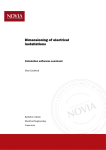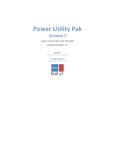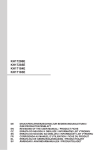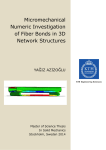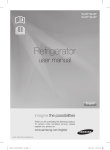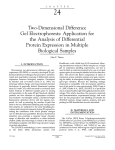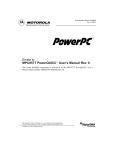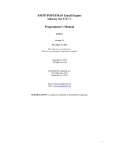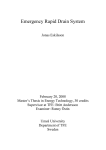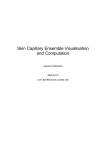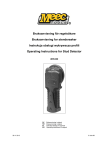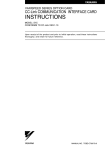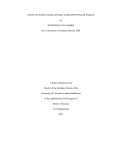Download Calculation tools for Series capacitor platforms
Transcript
Calculation tools for Series capacitor platforms MIKA HYVÄRINEN Master of Science Thesis Stockholm, Sweden 2009 Calculation tools for Series capacitor platforms Mika Hyvärinen Master of Science Thesis MMK 2009:96 MKN 020 KTH Industrial Engineering and Management Machine Design SE-100 44 STOCKHOLM Examensarbete MMK 2009:96 MKN 020 Beräkningsverktyg för plattformar till seriekompenseringsanläggningar Mika Hyvärinen Godkänt Examinator Handledare 2009-12-07 Ulf Sellgren Ulf Sellgren Uppdragsgivare Kontaktperson ABB FACTS Henrik Säfström Sammanfattning ABB är världsledande inom kraft- och automationsteknik och deras lösningar förbättrar prestanda och minimerar miljöpåverkan för energiföretag och industrier. ABB FACTS designar utrustning och anläggningar för serie- samt faskompensering. Detta examensarbete har utförts på ABB FACTS på avdelningen Mechanical Design (DM) i Västerås. Syftet med projektet var att ta fram beräknings- och simuleringsverktyg för plattformar som används av ABB FACTS i deras seriekompenseringsanläggningar. Examensarbetet har även fungerat som en utvärdering av FEM programmet SolidWorks Simulation. Examensarbetet inleddes med en förstudie där de normer och standarder som ABB FACTS måste ha i åtanke vid konstruerande undersöktes. Eftersom större delen av dessa seriekompenseringsanläggningar skickas till USA har den amerikanska standarden ASCE7-05 använts vid beräkningar av vind-, snö- och islaster. En referensram utvecklades där inhämtad kunskap från förstudien och tidigare projekt på ABB presenteras. Därefter påbörjades lastberäkningarna, modellerandet och simuleringarna av plattformarna samt utrustningen ståendes på dessa plattformar. Verktygen som användes under projektet var Excel, SolidWorks samt SolidWorks Simulation. Resultatet av examensarbetet blev ett beräkningsprogram framtaget i Excel samt fyra modeller för simuleringar i SolidWorks Simulation. Två av simuleringsmodellerna är uppbyggda så att de kan användas på de bärbara datorer som de flesta av de anställda på ABB FACTS använder. Den andra uppsättningen av modeller är tänkt att användas på ABB FACTS’s beräkningsdator. Skillnaden mellan dessa modeller är att i de förenklade modellerna har utrustningen ståendes på plattformarna ersatts med punktlaster. Modellerna har verifierats mot ABB Corporate Research. Även en manual och en rapportmall har tagits fram. Manualen förklarar hur användaren på enklast möjliga sätt kombinerar Excel beräkningarna med modellerna i SolidWorks Simulation. Rapportmallen är utformad så att användaren snabbt och enkelt kan föra in resultaten från beräkningarna samt simuleringarna för att sedan kunna skicka de till kund. i ii Master of Science Thesis MMK 2009:96 MKN 020 Calculation tools for Series capacitor platforms Mika Hyvärinen Approved Examiner Supervisor 2009-12-07 Ulf Sellgren Ulf Sellgren Commissioner Contact person ABB FACTS Henrik Säfström Abstract ABB is one of the world’s leading engineering companies in power and automation technologies and their solutions improve performance while lowering environmental impacts for energy companies and industries. ABB FACTS designs equipment and plants for series and phase compensation. This thesis has been performed at ABB FACTS on the Mechanical Design (DM) department in Västerås, Sweden. The purpose of the thesis was to develop and design calculations and simulation tools for ABB FACTS’s standard series capacitor platforms. The thesis has also served as an evaluation of the FEM program SolidWorks Simulation. The thesis began with a pre study where the standards and requirements that ABB FACTS has to consider during design were investigated. Since most of these series compensation plants are sent to the United States, the American standard ASCE7-05 was used in the calculations of wind, snow and ice loads. A reference frame was developed where knowledge obtained from the pre study and previous projects in the ABB is presented. After that, the load calculations, modeling and simulations of the platforms and equipment standing on these platforms began. The tools used in this project were Excel, SolidWorks and SolidWorks Simulation. The thesis resulted in a calculation program developed in Excel and four models for simulations in SolidWorks Simulation. Two simulation models were modeled so that they can be used on the laptops that most of the employees at ABB FACTS are using. The second set of simulation models are designed to run on ABB FACTS’s calculation computer. These models contains in addition to the platform also the equipment mounted on it. The models have been verified against ABB Corporate Research. A manual and a report template have also been developed. The manual explains how the user in the simplest way combines the Excel calculations with the models in SolidWorks Simulation. The report template is designed so that the results from the calculations and simulations easily can be entered and sent to the customer. iii iv FOREWORD This thesis work was performed at ABB FACTS in Västerås, Sweden, during the period June 2009 to November 2009. I would like to thank Jerker Norberg, manager of Mechanical Design for great support and interesting discussions during the work. I would also like to thank my co-workers Patrick Alila and Erik Engsten for the excellent guidance and good ideas through out this thesis. Finally I would like to thank my supervisors, Ulf Sellgren at KTH and Henrik Säfström at ABB FACTS. Mika Hyvärinen Västerås, November 2009 v vi NOMECLATURE Descriptions for wind calculations Symbol Description A Af Effective wind area [ m 2 ] Area of open buildings and structures [ m2 ] Ag Gross area [ m 2 ] Agi Sum of the gross surface areas of the building or structure [ m 2 ] Ao Total area of openings in a wall that receives positive Aoi external pressure [ m 2 ] Sum of the areas of openings in the building envelope [ m2 ] As a B b Gross area of the solid freestanding wall [ m 2 ] Width of pressure coefficient zone [ m ] Horizontal dimension of building measured normal to wind direction [ m ] Mean hourly wind speed factor ∧ b c Cf Gust speed factor Turbulence intensity factor Force coefficient F Grigid Design wind force for structures [ N ] Gust effect factor for rigid buildings and structures G flexible Gust effect factor for flexible buildings and structures gQ Peak factor for background response gR gv H h I Iz Peak factor for resonant response Peak factor for wind response Height of hill or escarpment [ m ] Mean roof height of a building or height of structure [ m ] Importance factor Intensity of turbulence K1 , K 2 , K 3 Multipliers to obtain K zt Kd Kh Kz K zt L Lz Wind directionality Velocity pressure exposure coefficient Velocity pressure exposure coefficient Topographic factor Horizontal dimension of a building parallel to the wind direction [ m ] Integral length scale of turbulence [ m ] Lr l N1 Horizontal dimension of return corner for a solid freestanding wall [ m ] Integral length scale factor [ m ] Reduced frequency [ Hz ] vii n1 Building natural frequency [ Hz ] p Q q qz R Ri s V W z z zg Design pressure to be used in determination of wind loads [ N / m 2 ] Background response factor Velocity pressure [ N / m 2 ] Velocity pressure evaluated at height z above ground [ N / m 2 ] Resonant response factor Reduction factor Vertical dimension of the solid freestanding wall [ m ] Basic wind speed [ m / s ] Width of building [ m ] Height above ground level [ m ] Equivalent height of structure [ m ] Nominal height of the atmospheric boundary layer used zmin Exposure constant Gust-speed power law exponent α ∧ α α β ∈ ∈ Reciprocal of α Mean hourly wind-speed power law exponent Damping ratio, percent critical for buildings or other structures Ratio of solid area to gross area for solid freestanding wall Integral length scale power law exponent Descriptions for snow calculations Symbol Ce Cs Ct hb hc Description hd ho I lu L pd Exposure factor Slope factor Thermal factor Height of balanced snow load [ m ] Clear height from top of balanced snow load to closest point on adjacent upper roof [ m ] Height of snow drifts [ m ] Height of obstruction above the surface of the roof [ m ] Importance factor Length of the roof upwind of the drift [ m ] Roof length parallel to the ridge line [ m ] Maximum intensity of drift surcharge load [ N / m 2 ] pf Snow load on flat roofs [ N / m 2 ] pg Ground snow load [ N / m 2 ] ps S Sloped roof snow load [ N / m 2 ] Roof slope run for a rise of one viii θ W Roof slope on the leeward side ( ° ) Horizontal distance from eave to ridge [ m ] ρs Snow density [ N / m3 ] Descriptions for ice calculations Symbol Description As Surface area of one side of a flat plate or the projected Ai D Dc fz Ii Iw K zt t td area of complex shapes [ m 2 ] Cross-sectional area of ice [ m 2 ] Diameter of a circular structure or member [ m ] Diameter of the cylinder circumscribing an object [ m ] Factor to account for the increase in ice thickness with height Importance factor Importance factor Topographic factor Nominal ice thickness due to freezing rain at a height [ m ] Design ice thickness [ m ] Vi Volume of ice [ m3 ] pi z Uniform distributed ice loads [ N / m 2 ] Height above ground [ m ] ρi Ice density [ N / m3 ] Abbreviations ABB ASEA Brown Boveri ASCE American Society of Civil Engineers CAD Computer Aided Design FACTS Flexible AC Transmission System FEM Finite Element Method MOV Metal Oxide Varistors RIV Radio Interference Voltage SC Series Capacitor ix x TABLE OF CONTENTS 1 INTRODUCTION 1 1.1 BACKGROUND 1.2 PURPOSE 1.3 DELIMITATIONS 1.4 METHOD 1.5 BENEFIT FOR ABB FACTS 1 1 1 1 2 2 FRAME OF REFERENCE 3 2.1 SERIES COMPENSATION 2.2 SERIES CAPACITOR 2.2.1 CAPACITOR BANK 2.2.2 METAL OXIDE VARISTORS 2.2.3 TRIGGER EQUIPMENT 2.2.4 DAMPING CIRCUIT 2.2.5 SPARK GAPS 2.2.6 FIBER OPTIC LINK 2.2.7 BY-PASS BREAKER 2.2.8 PLATFORM 2.3 LOADS 2.3.1 WIND LOADS 2.3.2 SNOW AND ICE LOADS 2.3.3 DEAD LOADS 2.3.4 EARTHQUAKES 2.4 NORMS AND STANDARDS 2.4.1 WIND LOADS 2.4.2 SNOW LOADS 2.4.3 ICE LOADS 3 4 5 6 6 6 7 7 7 7 9 9 9 10 10 10 10 10 10 3 METHOD 11 3.1 LOAD COMBINATIONS 3.2 LOAD AND TERRAIN CATEGORIES 3.3 WIND LOADS 3.4 SNOW LOADS 3.4.1 FLAT ROOFS 3.4.2 SLOPED ROOFS 3.4.3 RAIN ON SNOW 3.5 ICE LOADS 3.5 DEAD LOADS 3.6 PRE-STRESS LOADS 3.7 MODELING 3.7.1 PLATFORM 3.7.2 SUPPORTING INSULATORS 3.7.3 CAPACITOR BANK 3.7.4 DAMPING CIRCUIT 3.7.5 METAL OXIDE VARISTORS 11 11 12 17 17 18 19 20 21 21 22 22 22 23 24 24 xi 3.8 SIMULATION 3.8.1 BEAM OR SHELL ELEMENTS 3.8.2 CONNECTIONS AND FIXTURES 3.8.3 LOADS 3.4.4 MESH 25 25 25 26 28 4 RESULTS 29 4.1 THE CALCULATION TOOL 4.2 THE SIMULATION TOOL 4.1 THE USER MANUAL 4.1 THE REPORT TEMPLATE 29 30 30 30 5 VERIFICATION 31 6 DISCUSSION AND CONCLUSIONS 34 7 RECOMMENDATIONS AND FUTURE WORK 36 8 REFERENCES 37 APPENDIX A: Wind map 38 APPENDIX B: Snow map 40 APPENDIX C: Ice map 42 APPENDIX D: Cross sections 44 APPENDIX E: XML code 45 APPENDIX F: Report template 46 APPENDIX G: USER MANUAL 47 xii 1 INTRODUCTION In this chapter the background, the purpose, delimitations and the method used in this project are presented. 1.1 Background ABB FACTS (Flexible AC Transmission System) [1] is a part of ABB Power Systems [2] which designs equipment and plants for series compensation. These series compensation plants, also know as series capacitors (SC’s) [3], are electrical installations for increasing power transmission capacity. Series capacitors eliminate the steady-state voltage drop along the power lines as well as the voltage fluctuations associated with start-ups of large electrical loads. In this thesis, calculation and CAD models of the standard platforms that ABB FACTS uses in their series compensation plants are modeled and simulated based on the American standard ASCE7-05 [4]. 1.2 Purpose The purpose of this thesis is to design and develop calculations and simulation tools for ABB FACTS’s standard series capacitor platforms in SolidWorks [5] and SolidWorks Simulation [6]. Different load standards and requirements will be presented and interpreted. The models will be built after the two types of standard platforms used in ABB FACTS. These models will be designed in such a way that changes in dimensions and load cases easily can be made. A manual and a report template will also be presented. The manual will explain the structure of the models and the procedure of making changes in them. The manual will explain how the inputs are obtained and which parameters are to be fed into the models, but also describe how the results from the simulations in a simple way can be transferred in to a report. The manual will be written in Swedish and in English. 1.3 Delimitations Calculation and CAD tools will only be developed for the two types of standard platforms that ABB FACTS uses in their series capacitors. This thesis work confines to the American standard of ASCE7-05 in all load calculations since most of these series platforms are delivered to the United States. Only static loads will be considered, seismic and dynamic calculations are omitted entirely. No frequency analysis will be made in this project as this has previously been done at ABB for these platforms. 1.4 Method A pre study will be performed to investigate the standards and requirements that ABB FACTS has to consider when a series compensation plant is designed. The American standard of ASCE7-05 will be used in calculations of wind, snow and ice loads. These load calculations will be made in Excel [7] spreadsheets so that the loads acting on the standard platforms easily can be obtained. 1 CAD models of these standard platforms will be created in SolidWorks so that any changes in platform types, dimensions or load cases easily can be made. The task is also to examine whether these CAD models are to be built by beam or shell elements. The evaluation of these standard platforms will be performed by using SolidWorks Simulation (former known as Cosmos Works [8]). The results from the FEM simulations will be compared with results from ABB Corporate Research [9] in a sharp scenario. The manual that describes the approach of these calculations and simulations will be written so that the user easily can follow the reasoning step by step. Finally, a report template will be developed together with the employees at ABB FACTS so that it easily can be modified from one project to another. It will be designed so that the results from the calculations and simulations in a simple way can be entered and sent to the customer. 1.5 Benefit for ABB FACTS This thesis will result in following benefits for ABB FACTS: • Avoiding outsourcing all calculations and simulations at ABB Corporate Research, this will streamline the projects. • More reliable results, this will reduce the risk of over dimensioning. • Better and more reliable reporting data to the customers. • Evaluation of the FEM program SolidWorks Simulation. It is desirable to find out if this program is sufficiently strong and developed for the tasks that ABB FACTS encounters during their projects. 2 2 FRAME OF REFERENCE This chapter presents the theoretical reference frame and provides support and understanding for the remainder of the report. 2.1 Series compensation The reason for series compensation is essentially to increase transmission capacity into the power lines by reducing the reactance in it. The maximum capacity that can be transmitted from node 1 to node 2 at high voltage electricity can be approximated from equation 1 and 2 below. ⎛ U ⋅U ⎞ U ⋅U P1− 2 = max ⎜ 1 2 sin(δ ) ⎟ = 1 2 X ⎝ X ⎠ (1) U = f ( P, Q ) (2) U1 and U 2 represents the voltages at either end of the nodes, whereas δ denotes the angular difference of the two voltages. X is the reactance of the transmission circuit, while P and Q denote the received active and reactive power. Equation 1 suggests that the greater the reactance of a power line is the less power can be transferred through it. By installing series capacitors on the power line, the total reactance of the circuit can be reduced and maximum transmitted power can be provided. In Figure 1 below the difference between a power grid with and without a series capacitor is shown [10][13]. Figure 1. Power grid with and without a series capacitor [ABB Power Technologies AB, 2005]. 3 2.2 Series capacitor Long distances are often the main reason for the usage of series capacitors. Series capacitors work like boosters as they eliminates the steady-state voltage drop along the power lines as well as voltage fluctuations associated with high load start-ups. A standard one phase ABB series capacitor is constructed as shown in Figure 2, 3 and 4. It has a capacitor bank (a), several metal oxide varistors (b), a trigger equipment (c), a damping circuit (d), two spark gaps (e), a fiber optic link (f), a control platform (g), a by-pass breaker (h) and several Rodurflex’s (i). Every component is either standing on or connected to an insulated steel platform. It is this platform including the insulators supporting the platform that this thesis focuses on. Detailed information about the equipment standing on the platform is not presented in this public report due to confidentiality. b a h f i Figure 2. Layout of a one phase series capacitor. d e g Figure 3. Layout of a one phase series capacitor. 4 Figure 4. Layout of a one phase series capacitor. 2.2.1 Capacitor bank The capacitor bank shown in Figure 5 consist of capacitor units connected in parallel in sufficient number to handle the highest continuous current required of the load downstream of the bank. These parallel arrangements, or groups as they are called, are connected in series to provide the required ohmic value of compensation needed to provide the required voltage rise under the given operating conditions. Figure 5. Capacitor bank. 5 2.2.2 Metal oxide varistors The metal oxide varistors (MOV) shown in Figure 6 protects the capacitors against over-voltage. During ordinary conditions, all the power flows through the capacitor bank and when a fault arises the varistors limits the voltage across the capacitors. Figure 6. Metal oxide varistors. 2.2.3 Trigger equipment The trigger equipment is used to force trig the spark gaps and enable the by-pass of the series capacitors in situations where the varistors capacity is not sufficient to absorb the excess current during a fault sequence. 2.2.4 Damping circuit The damping circuit consists of two components, the reactor and the damping resistor. The purpose of the damping circuit shown in Figure 7 below is to limit and damp the discharge current caused by spark gap or closing of the switch. Figure 7. Damping circuit. 6 2.2.5 Spark gaps Spark gaps are normally used for immediate by-pass of the metal oxide varistors and the capacitors at internal or severe external faults or at demanding short circuit levels and duty cycles. 2.2.6 Fiber optic link For communication between platform and ground, fiber optic transmission links are utilized. 2.2.7 By-pass breaker The bypass breaker is an Auto-Puffer circuit breaker. With a closing time of half of what the other bypass switches have, makes it the fastest bypass switch available on the market for series compensation applications. This enables a great saving on metal oxide varistors in the protective scheme. 2.2.8 Platform There are two types of standard platforms, one with two transverse main beams and one with three, this is shown in Figure 8 below. The beam arrangement for a platform is adjusted regarding the spatial spreading of the equipment placed on it. The dimensions of the beams are usually limited to two or three different types. Figure 8. The two and the three beam platform. The platform module includes supporting insulators, the platform (steel structure) and supporting structure for all equipment placed on the platform. Handrails, corona protection, ladder and other details related to the platform are also included. Listed below is a brief description on some of the sub modules. • Platform, steel structure. ABB uses a hot dip galvanized steel structure in the design of the platforms. The platforms are designed with respect to easy handling and are completely prefabricated in the workshop to be bolted together at the construction site. For the personal safety the platforms are provided with a steel grating. The stressed beams have a material strength of 355 MPa, the non stressed beams have normally a lower material strength. 7 • Supporting insulators The insulators are made of homogeneous porcelain and can handle a torque of 8 kNm due to the mechanical joints located between the insulators and the platforms (steel structure and isolator platform), see Figure 9. The solution and design is depending on environment, voltage level and mechanical loads from the platform. Insulator Mechanical joints Insulator platform Figure 9. A supporting insulator, broken view. • Rodurflex The Rodurflex is not an ABB specific component, it is manufactured by LAPP Insulators [11]. The Rodurflex consists of a fiberglass core which is covered with 3 mm thick high temperature vulcanized silicone rubber that improves the systems mechanical characteristics but also protects the core during handling and installation. Since the insulators are made of porcelain, the Rodurflex’s are important because they absorb the tensions which the insulators are exposed to. A Rodurflex in a standard design can handle tensions of 210 kN [12]. • Corona protection. This sub module protects the platform and the equipment standing on it against radio interference voltage (RIV) and corona. There are two different aluminum profiles depending on voltage level. Fastening system is standardized to one standard solution. The corona protection also works as a handrail. The aluminum profile for the handrail is specially developed for ABB and after many years of experience it has shown that this is the best solution. The advantage with using the profile is the protective solution for corona protection and the easy erection. It has also the mechanical strength to prevent personal from falling of the platform. • Ladder The ladder gives a safe access to the platform. It is easy to handle and the turntable design minimize required space. The ladder can be equipped with interlocking to prevent human errors. There are two standard ladder solutions and one ladder design. The length of the ladder is adjusted depending on voltage level (length of the insulators). 8 • Equipment support There are two different standard solutions to support the varistors. Choice of support is depending on mechanical loads. For the reactor there is only one type of leg with variations on the height. 2.3 Loads A dynamic load is a load that gives rise to the supplement forces and deformations as a result of accelerations in the structure and load. A load is considered static if it does not cause significance acceleration for the structure. Many loads should be considered as dynamic, such as rotating loads, the load of people and machinery shocks. In many cases the structures dynamic conditions are not treated computationally and therefore these calculations can be performed in the same way as for static loads. At pulsating or alternating loads there are risks of resonance if the frequency of the load is close to the structures eigenfrequency. The dynamic effects can usually be neglected if the load frequency is one third of the structures eigenfrequency. If the load frequency is much higher than the eigenfrequency of the structure, the impact of load variations can be neglected due to the structure which acts as a vibration damper [14]. Given in this thesis is that the platforms should be considered as rigid with an eigenfrequency of 2 Hz. These calculations have been done in previous projects and will not be included in this report [15]. 2.3.1 Wind loads The wind load is inherently a dynamic load which means that its acceleration is affecting the structure. For structures with high stiffness and damping, that does not need to consider the structural vibration characteristics for the determination of wind load, the wind load can be treated as a static load. The wind load can sometimes be a fatigue loading. This applies mainly when the wind load causes a large number of oscillations of the structure. The velocity of the wind affecting the structure depends on the geographic location of the structure, surrounding terrain and the height of the structure. The effect of location is described by the reference wind speed and is mostly obtained from wind maps [14] [4]. 2.3.2 Snow and ice loads Snow loads are in the most cases assumed to be variable and bounded loads and determined as the weight per horizontal area. When determining the snow loads, the form of the structure has to be taken into account due to wind effects and risks of sliding. The characteristic snow pressure is often retrieved from snow maps. Ice loads are mostly generated by changes in the temperature and freezing rain. Freezing rain occurs when warm moist air is forced over a layer of subfreezing air at the earth’s surface. The precipitation usually begins as snow that melts as it falls through the layer of warm air aloft. The drops then cool as they fall through the cold surface air layer and freeze on contact with the structure [16] [4]. 9 2.3.3 Dead loads A dead load is a static load and consists of the weight of all materials incorporated with the structure, including the weight of all components standing on or in the structure [4]. 2.3.4 Earthquakes Depending on country and region, there is sometimes a risk of earthquakes. Earthquakes consist of dynamic forces that occur irregularly over time and to calculate these forces seismic studies are required. An alternative is to use sophisticated FEM programs, but ABB FACTS has not direct access to these programs and therefore are these kind of calculations omitted entirely in this thesis. 2.4 Norms and standards ABB FACTS is currently using several different standards. It is essentially the costumer’s geographical market that determines the use of norms and standards in a project. Since most of these platforms are delivered to the United States, the American standard ASCE7-05 is used throughout this thesis. ASCE or American Society of Civil Engineers is an ANSI accredited standards development organization that produces consensus standards under direction of the Codes and Standards Activities Committee. The ASCE standard 7-05 provides minimum load requirements for the design of buildings and other structures that are subject to building code requirements. Wind, snow, ice, dead and live loads as well as appropriate load combinations are interpreted and determined in this standard [4]. 2.4.1 Wind loads ASCE7-05 provides three different approaches to determine the wind load from which the designer can choose. An expanded simplified method in which the designer can select the wind pressures directly without any calculation if the building meets all the requirements, one wind tunnel procedure and one analytical method. In this project the analytical method is used consistently. 2.4.2 Snow loads The method of calculating the snow loads as ASCE7-05 offers is designed by static analysis of extreme values of snow amounts over a period of 50 years in the United States. 2.4.3 Ice loads This chapter deals with various ice scenarios, such as freezing rain, in-cloud icing, wind on ice and hoarfrost. 2.4.4 Dead loads The calculation of dead loads is very straight on in this standard and only a few pages are speared to these calculations. 10 3 METHOD This chapter describes the approach of load calculations, CAD modeling and FEM simulations. 3.1 Load combinations Structures, components, and foundations shall, according to ASCE7-05, be designed so that their design strength equals or exceeds the effects of the factored loads in equation 3. 1.2 ⋅ D + 1.6(Sor R) + 0.8 ⋅ W (3) The coefficient D stands for the dead loads, S for snow loads, R for rain loads and W for the static wind loads. ABB Corporate Research uses two design load combinations when designing series capacitor platforms. Equation 4 is for the transverse Y-direction and equation 5 for the longitudinal Xdirection of the platform. W−Y+T+D (4) W−X+T+D (5) T in equation 4 and 5 represents the terminal forces, Y stands for forces in the transverse direction of the platform and X is forces in the longitudinal direction. 3.2 Load and terrain categories When calculating on wind, snow and ice loads the ambient roughness has to be considered. Below follows a categorization of terrain roughness from ASCE7-05. Exposure B shall apply where the ground surface roughness condition, as defined by Surface Roughness B, prevails in the upwind direction for a distance of at least 792 m or 20 times the height of the building, whichever is greater. Surface Roughness B: Urban and suburban areas, wooded areas, or other terrain with numerous closely spaced obstructions having the size of single-family dwellings or larger. Exposure C shall apply for all cases where Exposures B or D does not apply. Surface Roughness C: Open terrain with scattered obstructions having heights generally less than 9 m. This category includes flat open country, grasslands and all water surfaces in hurricane prone regions. Exposure D shall apply where the ground surface roughness, as defined by Surface Roughness D, prevails in the upwind direction for a distance greater than 1524 m. Surface Roughness D: Flat, unobstructed areas and water surfaces outside hurricane prone regions. This category includes smooth mud flats, salt flats and unbroken ice. 11 3.3 Wind loads The design wind loads are determined according to equation 6 below. F = qz ⋅ G ⋅ C f ⋅ A f (6) The velocity pressure qz is calculated from equation 7. The numerical coefficient 0.613 is only used when no other climate data is available for the region. qz = 0.613 ⋅ K z ⋅ K zt ⋅ K d ⋅V 2 ⋅ I (7) The velocity pressure exposure coefficient K z can be obtained from a Table 1, but the most accurate value on K z is given by equation 8. ⎛ 15 ⎞ K z = 2.01⎜ ⎟ ⎜ zg ⎟ ⎝ ⎠ 2 α (8) The terrain exposure constants α and z g in equation 8 are obtained from Table 2 on the next page. Table 1. The velocity pressure as a function of height and roughness category [ASCE, 2006]. 12 Table 2. Terrain exposure constants [ASCE, 2006]. The topography factor K zt is calculated according to equation 9, but the most critical approach is when K zt reaches the value 1. For that reason K zt will be set to 1 through all calculations and simulations in this thesis work. K zt = (1 + K1 + K 2 + K 3 ) 2 (9) The wind directional factor K d is obtained from Table 3 below. Table 3. The wind directional factor as a function of structure type [ASCE, 2006]. The speed of wind V varies greatly depending on the country and region. Therefore, this constant is determined from a wind map. In Appendix A, a wind map of the United States is presented. The importance factor I used in equation 7 diversifies from 0.77 to 1.15 depending on if the region in which the plant or building is standing has a higher risk of hurricanes. This is shown in 13 Table 4 below. Only category IV (four), which includes communication towers, fuel storage tanks, cooling towers and electrical substation structures, is treated in this thesis. Table 4. The importance factor of the wind loads [ASCE, 2006]. Depending on whether the structure is considered as rigid (natural frequency, f ≥ 1 Hz ) or flexible (natural frequency, f < 1 Hz ) the gust effect factor G is determined in different ways. For a flexible structure the gust effect factor is calculated according to equation 10 and for a rigid structure according to equation 11. ⎛ 1 + 1.7 ⋅ I g 2 ⋅ Q 2 + g 2 ⋅ R 2 Q R z G flexible = 0.925 ⎜ ⎜ 1 + 1.7 ⋅ gv ⋅ I z ⎝ ⎞ ⎟ ⎟ ⎠ ⎛ 1 + 1.7 ⋅ gQ ⋅ I z ⋅ Q ⎞ Grigid = 0.925 ⎜ ⎜ 1 + 1.7 ⋅ g ⋅ I ⎟⎟ v z ⎝ ⎠ I z which is the intensity of turbulence at height z is calculated by equation 12. (10) (11) 1 ⎛ 10 ⎞ 6 Iz = c ⎜ ⎟ ⎝ z ⎠ (12) The terrain exposure constant c is obtained from Table 2, the equivalent height of the structure z is defined as 0.6 times the height of the structure, but not less than zmin shown in Table 2. The background response Q used in both equation 10 and 11 is given by equation 13 below. Q= 1 ⎛ B+h⎞ 1 + 0.63 ⎜ ⎜ L ⎟⎟ ⎝ z ⎠ (13) 0.63 The integral length scale of turbulence at the equivalent height Lz is calculated according to equation 14 below. The terrain constants l and ∈ used in equation 14 are listed in Table 2. ∈ ⎛ z ⎞ Lz = l ⎜ ⎟ ⎝ 10 ⎠ (14) 14 gQ and gv which represents the peak factors of background and wind response shall according to ASCE7-05 always be taken as 3.4. g R , the peak factor for resonant response is given by equation 15, where n1 stands for the structures natural frequency. 0.577 (15) g R = 2 ln(3600 ⋅ n1 ) + 2 ln(3600 ⋅ n1 ) R , the resonant response factor used in equation 10 for calculating the flexible guest factor is obtained from equation 16 below 1 R= R ⋅ R ⋅ R (0.53 + 0.47 ⋅ RL ) (16) β n h B where 7.47 ⋅ N1 Rn = (17) 5 3 (1 + 10.3 ⋅ N1 ) N1 = n1 ⋅ Lz (18) Vz α ⎛ z ⎞ Vz = b ⎜ ⎟ V ⎝ 10 ⎠ 1 (1 − e −2η ) for η > 0 η 2η 2 Rl =1for η = 0 Rl = 1 (19) − (20) (21) The subscript l in equation 20 and 21 shall be taken as h , B and L . 4.6 ⋅ n1 ⋅ h Rl = Rh by setting η = Vz (22) Rl = RB by setting η = 4.6 ⋅ n1 ⋅ E ⋅ B Vz (23) Rl = RL by setting η = 15.4 ⋅ n1 ⋅ L Vz (24) The force coefficient C f used in the main equation for determining the design wind loads varies slightly depending on the member geometry and is most easily retrieved from Table 5 below. Table 5. The force coefficient for round and flat members [ASCE, 2006]. 15 ∈ in Table 5 represents the ration of solid area to gross area. This constant should not be mixed up with the terrain constant ∈ in Table 2. Af used in equation 6 is the projected area normal to the wind. 16 3.4 Snow loads Depending on the roof type, the snow loads are calculated in different ways. Below follows the calculations used depending on difference in roof type. 3.4.1 Flat roofs For a flat roof the snow loads are determined by equation 25. A roof classifies as flat if its slope is less than 5 degrees. p f = 0.7 ⋅ Ce ⋅ Ct ⋅ I ⋅ pg (25) The exposure factor Ce and the thermal factor Ct are obtained from Table 6 and Table 7 below. Table 6. The exposure factor [ASCE, 2006]. Table 7. The thermal factor [ASCE, 2006]. I , the importance factor is found in Table 8. As mentioned in chapter 3.3 Wind loads this thesis will only treat buildings classified as category IV (four), which includes electrical substations and plants, so this factor is set to 1.2 through all snow load calculations. Table 8. The importance factor depending on building category [ASCE, 2006]. The ground snow loads pg used in equation 25 is obtained from a snow map. Appendix B shows a snow map for the United States. Snow loads are set to zero in Hawaii, and for colder locations in Alaska Table 9 is used. 17 Table 9. Ground snow loads for locations in Alaska [ASCE, 2006]. 3.4.2 Sloped roofs Snow loads acting on sloped roof is assumed to act on a horizontal projection of that surface. The sloped roof loads are obtained by multiplying the flat roof snow loads by the slope roof factor Cs , shown in equation 26 below. ps = C s ⋅ p f (26) For warm roofs ( Ct ≤ 1 as determined from Table 7) the slope factor is determined by using Figure 10a. Cold roofs are those with a thermal factor larger than 1.0. For a cold roof with a Ct value of 1.1 the slope factor is determined by Figure 10b and for those with a Ct value of 1.2 the Figure 10c is used. Figure 10. The slope factor for warm and cold roofs [ASCE, 2006]. 18 3.4.3 Rain on snow For locations where the ground snow loads are 0.96 kN / m 2 or less, but not zero, and for roofs with slopes less than the width of the building divided by the factor 15.2, a 0.24 kN / m 2 rain on snow surcharge shall be applied. 19 3.5 Ice loads The uniform distributed ice loads pi due to freezing rain are calculated from equation 27 pi =ρi ⋅ Ai ⋅ g (27) were ρi represents the density of the ice and shall not be set less than 900 kg / m3 . The cross sectional area of the ice Ai is obtained from equation 28. Ai = π ⋅ td ( Dc + td ) (28) The design ice thickness td used in the equation for the cross sectional area is calculated from equation 29. td = 2.0 ⋅ I i ⋅ f z ( K zt )0.35 (29) The importance factor I i is set to 1.25 for electrical substations and plants. For other structures, see Table 10. Table 10. The importance factor for ice thickness depending on building category [ASCE, 2006]. f z is a height factor and is used to increase the radial ice thickness above the ground and is determined from equation 30. ⎛ z ⎞ fz = ⎜ ⎟ ⎝ 10 ⎠ 0.10 for 0 m < z ≤ 275 m (30) For altitudes above 275 m the height factor is set to 1.4. The topographic factor K zt is the same as in the wind calculations, and as mentioned in chapter 3.3 Wind loads, the most critical approach is when K zt reaches the value 1. Therefore is this constant set to 1 through all calculations and simulations in this report. Dc in equation 28 is the characteristic diameter of the cylinder circumscribing the profile which the structure is constructed by. Appendix D shows the characteristic diameter for a variety of cross sections. 20 3.5 Dead loads After careful consideration together with higher courts at ABB FACTS, the dead load will in addition to the platform with supporting insulators only consist of the capacitor bank, the damping circuit and the metal oxide varistors. These components weigh, compared to the other equipment on the platform, considerably more. It is also these components that have the largest effective load surface. Depending on the platform type and size, the total dead load varies from 40000 to 60000 kg. When calculating on the weight of the platform, 105 kg / m 2 can be used as a reference figure. This gives, in a standard version, a two beam platform a total weight of approximately 9000 kg and a three beam platform a total weight of about 12000 kg. The weight of a supporting insulator depends on the length of it, which in turn depends on the plants voltage level. Somewhere between 700 and 1000 kg can be expected that an insulator in its standard version weighs. The capacitor bank has a weigh of about 9000 kg per stack. The number of stacks varies depending on the plant size and location, but in a typical case the capacitor bank have two stacks and weighs 25000 kg on a two beam platform. On a three beam platform the capacitor bank have four stacks, this result in a weight of 50000 kg. The weight of a damping circuit varies slightly depending on the plant size, but on average, this module weighs about 2000 kg. The metal oxide varistors have a weight of approximately 4500 kg, plus minus a couple of hundred kilos depending on the number of varistors units and terminals. 3.6 Pre-stress loads Pre-stressing forces in the diagonally mounted Rodurflex’s, see Figure 11, are in this report named as pre-stress loads. These loads are for the most of ABB’s plants set to 20 kN. Figure 11. The Rodurflex with black arrows representing the pre-stress loads. 21 3.7 Modeling No deeper breakdown of the model creating will be presented in this chapter, the reader is assumed to possess basic knowledge in this area. Dimensions and other sensitive information will not be presented in this general report due to confidentiality. The models are modeled so that the dimensions and structure quickly and easily can be modified. All models are constructed of 3D sketches. In addition to regular models, simplifications are developed to facilitate and speed up the simulations. 3.7.1 Platform The base of the platform consists of either two or three HEA beams, depending on platform type. Across these beams are four capacitor beams, four apparatus support beams and several grating support beams placed, all beams of the type HEA. The cross beams, marked blue in Figure 12, stiffens the platform. These cross beams together with the outer frame are modeled from an Lprofile. The command “Structural Remember” is used for all beams in the platform, this feature keeps the model size down. Figure 12. CAD model of a three beam platform with blue marked cross beams. 3.7.2 Supporting insulators The supporting insulators are modeled in three subassemblies; the porcelain insulator, the insulator platform and the upper end joint. The porcelain insulator is modeled as a single solid piece. With the command “Revolve” in SolidWorks a 3D profile is created from a 2D sketch. The material in this 3D profile is set to homogenous porcelain. The insulator platform consists of several parts, see Figure 13 on the next page. On top of the bottom plate, which is the base of the model and created by an “Extrude”, stands a square tube built by the command “Structural Member”. Four support plates are connecting the bottom plate with the square tube. Above the square tube are two square plates located with a mechanical joint between them. These three elements, along with the supporting plates, are modeled with the command “Extrude”. 22 Figure 13. CAD model of the supporting insulator platform. The upper end joint consists of a circular and a square plate, between these is the mechanical joint located. The material in the insulator platform and the upper end joint is set to galvanized steel. 3.7.3 Capacitor bank The capacitate stack, shown in Figure 14 below, consists only of a capacitor unit, a capacitor frame and an insulator. These components are then multiplied by using linear and circular patterns, this in order to reduce the model size. The capacitor frame is modeled as a solid block with “Extruded Cuts” in several directions. The capacitor unit is an extruded body with a circular connection. A revolved 2D sketch forms the insulators. Figure 14. CAD model of a capacitor stack. 23 3.7.4 Damping circuit The damping resistor is mainly designed with the “Revolve” and the “Extrude” command. The connections are modeled with the “Sweep” command. The reactor and the insulators which the reactor is standing on are modeled using “Revolve”. The mounts between the reactor and the insulators are made from two L-profiles by using “Structural Member”. The other components in this assembly are made from by “Extrude”. Both the reactor and the damping resistor are shown in Figure 15 below. Figure 15. CAD model of the damping circuit. 3.7.5 Metal oxide varistors The tripod to the metal oxide varistors is modeled from six UPE beams and four ABB specific beams, using the “Structural Remember” feature. The varistors are designed with the “Revolve” and “Linear Pattern” command. The result is shown in Figure 16. Figure 16. CAD model of the metal oxide varistors. 24 3.8 Simulation As mentioned in chapter 3.7 Modeling, there are in addition to regular models also simplifications, this results in four simulation models; two for three beam platform and two for two beam platform. One of the models in each platform type is designed to run on laptops and does not containing the equipment standing on the platform. The equipment and the forces acting on them are replaced by point forces. The second set of simulation models are designed to run on ABB’s calculation computer. These models contains in addition to the platform also the equipment mounted on it. The results between the regular and the simplified models do not differ. The main reason for using the complete regular models is to give the costumer a more accurate visual perceptive. 3.8.1 Beam or shell elements The task to examine whether the models are to be built up of beam or shell elements was developed at a time when ABB still was using Cosmos, today known as SolidWorks Simulation. Cosmos gave the user the ability to choose a way of meshing the model at the beginning of each study. In SolidWorks Simulation, this feature has been removed and replaced with an automatic “Mixed Mesh”. By default, any surface bodies will be treated as shell elements, any structural members will be treated as beam elements, and everything else will be treated as solid elements. The platforms, excluding the outer frames, are in these simulations meshed as beams as this speeds up the simulations. The outer frames are meshed as solid since wind loads are affecting on these surfaces and SolidWorks Simulation does not support pressure on beam elements. The support insulators are meshes as solid. 3.8.2 Connections and fixtures When using both beam and solid elements in a simulation, bonded contact sets between these elements are needed. Bonded entities behave as if they were welded or bolted. Rigid connectors are placed between the insulator platform and the square tube standing on it. These rigid connectors rigidly connect faces from one solid body to faces from another solid body. In this case rigid connectors simulate the welds, which have been removed to allow the simulations. To simulate the foundation bolts, fixed support is used in the holes on the insulator platform, see Figure 17. Figure 17. Fixed support on the insulator platform. 25 The mechanical joints in the supporting insulators, illustrated in Figure 18, have a structure that resembles a universal joint. These joints have in the simulation models been replaced by simple square blocks. To make the models as close as to reality, these blocks are in the ends connected with “Hinge” connections. The “Hinge” connections are locked so that they only allow movement in two directions and entirely limit rotations along the insulators. Figure 18. The mechanical joint in the supporting insulators. 3.8.3 Loads The equivalent force magnitude acting on the platform generated by pressure is equal to the pressure times the area, this is shown in Figure 19 for an insulator on the next page. The size of the wind pressure depends on the height of the platform since the pressure increases with increasing distance from the ground. It is important to apply the right pressure on the right area and height. In the same way as for wind loads, force equals pressure times area, the snow and ice loads are applied on the platform and equipment. The advantage with calculating forces in this way is that the user only needs to calculate the pressure acting on the surface. In the regular models, SolidWorks determines the surface areas and hence the forces acting on the platform and equipment. In the simplified models the user has to determine the effective load surface, preferably from a dimensioned drawing and manually calculate the magnitude of the force. In addition to the external forces there are weights of the equipment, dead loads, affecting on the platform. These forces are in the simplified models set as point masses with the direction to the ground. In the regular models, SolidWorks generates these loads if the right material properties are given for all components. 26 Figure 19. An insulator with the right pressures at the right areas. The diagonal mounted Rodurflex’s and the pre-stress loads located in them are simulated with tension springs. These springs have an axial stiffness of 2.5 ⋅106 N/m and a tension preload force of 20 kN. The springs are attached to the support plates down on the insulator platform and the other end is attached at the upper end joint on the support insulator standing next, this is illustrated in Figure 20 below. Figure 20. Two supporting insulators with the tension spring between them. 27 3.4.4 Mesh In these models, SolidWorks Simulation only generates a working mesh when all settings are set to the highest and finest (this is a documented error that often occurs for large assemblies), this gives that no convergence study can be done for the results generated by SolidWorks Simulation. The elements in the models have a global size of 50 mm and a tolerance of 3 mm. The few available mesh settings are shown in Figure 21. Figure 21. Mesh settings in SolidWorks Simulation. The mesh for a simplified three beam platform is shown in figure 22 below. Figure 22. The mesh of a three beam platform. 28 4 RESULTS This chapter presents and summarizes the results from this thesis. 4.1 The calculation tool The calculations are made as previously mentioned in Excel with a work sheet for each load calculation, see Figure 23. The user only needs to have the dimensions of the plant and the geographic location in mind, the calculation tool generate the right wind, snow and ice pressure as a function of height. The XML code for the Excel program is available at Appendix E. Figure 23. The Excel worksheets. 29 4.2 The simulation tool This part resulted in four models designed in SolidWorks, two regular models and two simplified models. Two of these, the simplified and the regular three beam model are shown in Figure 24. The main reason for why there exist regular models is the visual requirements from the costumers. These customers want to ensure that the equipment standing on the platform is included in the calculations. The results between the simplified and regular models do not differ. Figure 24. A regular and a simplified version of a three beam platform. 4.1 The user manual The user manual describes how to use the Excel calculation program and the simulation models in SolidWorks Simulation, and how to combine the calculations and simulations in the easiest way. The manual is given in Appendix G. 4.1 The report template The report template, which is given in Appendix E is designed so that the results from the calculations and simulations quickly and easily can be entered and sent to the customer. 30 5 VERIFICATION This chapter presents the way of verification made in this thesis. The simulation models developed in this thesis is verified against the results produced by ABB Corporate Research. ABB Corporate Research uses a self-developed FEM program called Ramses [17]. Based on values from sharp scenarios, displacements in the platforms, see Figure 25 and 26, and forces in the foundation, shown in Figure 27 and 28, are calculated and compared. No specific values from the simulations will be presented in this public report due to confidentiality. Figure 25. The displacement on a three beam platform. 31 Figure 26. The displacement on a three beam platform generated from Ramses [S.Berggren, 2009]. The displacement results from the two independent models differ from 5 % to 11 % under extreme circumstances. Figure 27. The foundation forces generated from the SolidWorks Simulation model. 32 Figure 28. The foundation forces generated by Ramses [S.Berggren, 2009]. The difference between the foundations loads calculated with SolidWorks Simulation varies at maximum 7 % from the values calculated with Ramses. With these reasonable differences in the results, the models can be considered as correct. 33 6 DISCUSSION AND CONCLUSIONS This chapter summarizes this thesis and the results presented in previous chapters are discussed. Initially only wind loads was meant to be considered in the calculations and simulations but after discussions with the supervisor at ABB FACTS, snow and ice loads was committed. However, there is no material to verify simulations with snow and ice loads at the moment. Although the results from the calculations and simulations are in line with the results from ABB Corporate Research, critical thinking should be used by the user when analyzing the results. In the reference material from ABB Corporate Research, the height from the ground to the center of the equipment is not taken in account when the pressure is calculated and applied on the model. Also, a surcharge of 15 % is applied on as extra margin by ABB Corporate Research in assessment of the wind loads. These differences between the inputs in the models presented in this report and the models used by ABB Corporate Research contributes most likely to differences in the final results, although the differences are very small and the results can be considered as very good. There are a number of uncertainties identified during the project, however due to lack of time and for practical reasons these uncertainties could not be investigated sufficiently. Below follows a short brief of the identified uncertainties: • The load cases applied to the models are theoretical. Local variations in wind, snow and ice loads can of course occur. • Uncertainty in the insulator platform. It is uncertain how the program handles the connection (Rigid Connector) between the bottom plate and the square tube and if the force is transmitted as in a real weld. • Inadequate Mesh, the mesh properties in SolidWorks Simulation are insufficient and only a small amount of changes can be made by the user. • Since “Remote Load” can not be applied on beam elements, there is an uncertainty in how much torque that is lost when the loads is placed directly on the equipment support. However, this only concerns the simplified models. • A major uncertainty is how easy the platforms fall into self oscillation. This phenomenon is probably more noticeable the higher the platforms are. The Excel calculations with the SolidWorks models can profitable be used in calculations and simulations of wind loads on series capacitor platforms, but the user should check the reliability of the results before they are submitted to the customer. This thesis has also served as a test of the FEM program SolidWorks Simulation. It was desirable to find out if this program is sufficiently strong and developed for the tasks that ABB FACTS encounter during their projects. During this thesis, it was found that SolidWorks Simulation has developed a lot since the previous version, but unfortunately not enough. Meshes containing both solid and beam elements (Mix Mesh) does not work satisfactorily and the support of beam elements is still very poor, for example does not remote load always work as planed on beam elements. Although this is a supplementary module to the SolidWorks and it is very cleverly 34 integrated into the modeling program, ABB FACTS should investigate and try other FEM simulation programs available on the market. 35 7 RECOMMENDATIONS AND FUTURE WORK In this chapter recommendations and future work are presented. It is recommended that the ABB FACTS changes to a more reliable and recognized FEM simulation program. During this thesis, SolidWorks Simulation has proven to be a fully functional program, but that it is not suitable for large and more advanced simulations. The program lacks the ability to limit the mesh area (the entire model must be meshed), the poor handling of beam elements and the bug that prevents the “Remote Load” sometimes to be applied on beam elements are some of the reasons which makes that SolidWorks Simulation does not feel stable and fully developed. It is possible that these errors have been corrected in some new service pack, but it nonetheless strongly recommended that ABB tries other FEM simulation programs available on the market. There is a lot of more work that can be done to improve and develop these models, especially the simulation models. Below follows suggestions of future work. Linking values from Excel to load magnitudes in SolidWorks Simulation and results from SolidWorks Simulation back to Excel are future work which with the time and knowledge available should be resolved quickly. A version of the Excel program which focuses on the IEEE standard would also likely to be done in the future. Since there at the moment are not material to verify the ice and snow simulations and load simulations on the two beam platform is it essential that these verifications are done as soon as possible. Even if it is given in this thesis that these platforms have an eigenfrequency of 2 Hz, is it of interest to verify and check when the platform ports in self-oscillation by doing a frequency analysis. In the simulation models there are several changes that could have been done if the calculation computer had come at an earlier stage of this thesis. The regular models are currently very unstable, only about every fifth simulation generates a result. Instability in the models is the main reason for these failures. Instead of using “Fixed Support” on the insulator platforms, “Ground Bolt Support” could be used. This is something that was meant to be used during the thesis since it would facilitate the foundation force calculations, but after several failed simulations this option was disregarded and replaced with “Fixed Support”. The “Spring Connections” representing the Rodurflex’s could be replaced with solid models so that the user can verify that Rodurflex’s handles the tensions as intended. In the future it would be of interest to add the other components standing on the platform to the simulation models. This would provide an even more real scenario, but to verify these upcoming models ABB Corporate Research would have to modify their Ramses models as they only contain the platform with capacitor bank, reactor and metal oxide varistors. 36 8 REFERENCES 1. ABB FACTS, http://www.ABB.se/FACTS 2. ABB Power Systems, http://www.ABB.se/cawp/seabb361/de8b3dc527cc563bc1256a69004f1e57.aspx 3. “SC Series Compensation” (2005), ABB Power Technologies AB 4. “Minimum Design Loads for Buildings and Other Structures” (2006), the American Society of Civil Engineers, ISBN 0-7844-0809-2 5. SolidWorks Copyright© 1995-2009 Dassault Systems 6. SolidWorks Simulation Copyright© 1997-2008 Dassault Systems 7. Microsoft Office Excel 2003 Copyright© 1985-2003 Microsoft Corporation 8. Cosmos Works, http://www.cosmosm.com/ 9. ABB Corporate Research, http://www.ABB.com/secrc 10. “Det finns ett bättre sätt” (1998), ABB Power Technologies AB 11. LAPP Insulators, http://www.lappinsulator.com/ 12. LAPP Insulators, http://www.lappinsulator.com/pdf/Catalogs/Rodurflex/RodurflexCatalog.pdf 13. “Series compensation of power system”(1996), P. M Anderson, ISBN 978-1888747010 14. ”Bärande konstruktioner och laster” (1996), S-O Björk, ISBN 91-7332-762-X 15. “IEEE693-2005, A.1.3.2” Static coefficient method 16. ”Konstruktionsregler” (1995), Boverket, ISBN 91-7147-175-8 17. Ramses - FEM-program for Linear Static and Dynamic Analysis of Structures, ABB AB Corporate Research, Sweden Literature and references used as support for the calculations and simulations: 18. “A Beginner’s Guide to ASCE 7-05”, http://www.bgstructuralengineering.com/BGASCE7/ 19. “Minimum Design Loads for Buildings and Other Structures” (2006), online version, http://www.ce.udel.edu/courses/CIEG407/CIEG_407_Protected/ 20. “Excel 2003 Bible”(2003), John Walkenbach, ISBN 0764539671 21. Excel calculation forum, http://www.excelcalcs.com/forum/ 22. “Modellering av avancerade sammanställningar”(2008), MP Engineering AB 23. ”RAM Standard - Beräkningar för stålkonstruktioner”, ABB Power Systems, pärm 8A 24. ”Alpha series capacitor platform for Eskom South Africa” (2009), S Berggren, ABB AB Corporate Research 25. “Strength analysis of series capacitor platform for Serumula” (2008), S Berggren & B Häggblad, ABB AB Corporate Research 37 APPENDIX A: Wind map Appendix A, wind map for the United States from ASCE7-05 38 39 APPENDIX B: Snow map Appendix B, snow map for the United States from ASCE7-05 40 41 APPENDIX C: Ice map Appendix C, ice map for the United States from ASCE7-05 42 43 APPENDIX D: Cross sections Appendix D, cross sections used in the ice load calculations, obtained from ASCE7-05 44 APPENDIX E: XML code This part has been removed due to the number of pages. The code can be obtained by sending an email to: [email protected] 45 APPENDIX F: Report template This part has been removed in this public report due to confidentiality 46 APPENDIX G: USER MANUAL This manual has been modified and some parts have been left out in this public report due to confidentiality 47 48 User manual SC platform simulations MIKA HYVÄRINEN User manual Västerås,2009 User manual SC platform simulations USER MANUAL ABB FACTS DM SE-722 12 VÄSTERÅS USER MANUAL SC platform simulations Mika Hyvärinen Approved Commissioner Contact person 2009-11-13 ABB FACTS / DM Jerker Norberg Abstract This manual is created as a part of a thesis made at ABB FACTS and the department DM. The purpose of the thesis is to develop and design calculations and simulations models for ABB FACTS’s standard series capacitor platforms in SolidWorks and SolidWorks Simulation. The American standard of ASCE7-05 is used in calculations of wind, snow and ice loads since most of these series platforms are delivered to the United States. The load calculations are made in several Excel work sheets and the simulations are performed in SolidWorks Simulation (former know as Cosmos). This manual explains how to use the Excel calculation program, simulation models in SolidWorks Simulation and how to combine the calculations and simulations in the easiest way. i ii TABLE OF CONTENTS 1 Introduction 1 1.1 ASCE STANDARD 7-05 1.1.1 WIND LOADS 1.1.2 SNOW LOADS 1.1.3 ICE LOADS 1.1.4 DEAD LOADS 1.2 SOLIDWORKS SIMULATION 1 1 1 1 1 1 2 Calculations and simulations 2 2.1 EXCEL CALCULATION 2.1.1 WIND LOADS 2.1.2 SNOW LOADS 2.1.3 ICE LOADS 2.2 SIMULATIONS 2.2.1 STARTING A SIMULATION 2.2.2 CONNECTIONS AND FIXTURES 2.2.3 LOADS 2.2.4 MESH AND RUN 2.2.5 RESULTS 2 2 4 6 7 7 8 11 15 16 iii 1 INTRODUCTION 1.1 ASCE standard 7-05 ASCE or American Society of Civil Engineers is an ANSI accredited standards development organization that produces consensus standards under direction of the Codes and Standards Activities Committee. The ASCE standard 7-05 provides minimum load requirements for the design of buildings and other structures that are subject to building code requirements. Wind, snow, ice, dead and live loads as well as appropriate load combinations are interpreted and determined in this standard. 1.1.1 Wind loads ASCE7-05 provides three different approaches of determine the wind load from which the designer can choose. An expanded simplified method in which the designer can select the wind pressures directly without any calculation if the building meets all the requirements, one wind tunnel procedure and one analytical method. In this manual the analytical method is used consistently. 1.1.2 Snow loads The method of calculating the snow loads as ASCE7-05 offers is designed by static analysis of extreme values of snow amounts over a period of 50 years in the United States. 1.1.3 Ice loads This chapter deals with various ice scenarios, such as freezing rain, in-cloud icing, wind on ice and hoarfrost. 1.1.4 Dead loads The calculation of dead loads is very straight on in this standard and only a few pages are speared to these calculations. 1.2 SolidWorks Simulation SolidWorks Simulation, former known as Cosmos, is an expansion to SolidWorks and is used to perform finite element analysis. Further than the simplified version “Xpress” which is included in all SolidWorks licenses, there is a heavier “Professional” version and it is this which is used through all simulations in this manual. 1 2 CALCULATIONS AND SIMULATIONS 2.1 Excel calculation Before the calculations can be initiated, the user needs to know where the series compensator will be located geographically and the dimensions off it. 2.1.1 Wind loads The inputs for the wind load calculations, shown in Figure 1 below, are marked as yellow cells. The white cells are results and can not be modified. Figure 1. The input data for the wind load calculations. 2 The wind speed is obtained from the wind map included as a separate work sheet named “Wind map”. The occupancy category can be changed, but for calculations on series capacitors category four is used. (Category four includes communication towers, fuel storage tanks, cooling towers and electrical substation structures). The exposure category is defined as follows: • Category B: Urban and suburban areas, wooded areas, or other terrain with numerous closely spaced obstructions having the size of single-family dwellings or larger. • Category C: Open terrain with scattered obstructions having heights generally less than 9 m. This category includes flat open country, grasslands and all water surfaces in hurricane prone regions. • Category D: Flat, unobstructed areas and water surfaces outside hurricane prone regions. This category includes smooth mud flats, salt flats and unbroken ice. The topography factor is calculated as K zt = (1 + K1 + K 2 + K 3 ) , but the most critical approach is when K zt reaches the value 1 and 2 therefore this factor should be set as 1 through all calculations. The height, width and length of the structure are information that the user must know before calculations can begin. The damping ratio varies from 0.01 to 0.07, but according to IEEE693-2005, A.1.3.2 “Static coefficient method” this factor should be set as 0.02 for these platforms. The structure period coefficient has suggested range of values from 0.020 to 0.035 It is only used in the calculation when a structure is considered “flexible”. A structure is considered “flexible” when it has a natural frequency, f < 1 Hz. Otherwise the structure is considered “rigid”. The wind directionality factor is set to 0.85 through all calculations. The force coefficient is calculated differently depending on how the surface where the wind affects appears. After the correct input data is entered, Excel generates the output data, see Figure 2, which is to be fed into the simulation models. The output of the wind load calculations is a correct wind pressure as a function of the height and the force coefficient. 3 Figure 2. The output data for the wind load calculations. 2.1.2 Snow loads The in- and outputs for the snow load calculations are shown in Figure 3. Figure 3. The in and output data for the snow load calculations. 4 The occupancy category can be changed but as in the wind calculations, category four is used for calculations on series capacitors. The ground snow load is obtained from a snow map included as a work sheet named “Snow map”. The length of the high and low roof, the distance from eave to ridge, roof type and obstructions height are information that the user need to have before calculations can begin. The exposure factor is defined as follows: Terrain Category B C D • • • Fully Exposed 0.9 0.9 0.8 Partially Exposed 1.0 1.0 0.9 Sheltered 1.2 1.1 1.0 Partially Exposed: All roofs except as indicated below. Fully Exposed: Roofs exposed on all sides with no shelter afforded by terrain, higher structures or trees. Roofs that contain several large pieces of mechanical equipment, parapets which extend above height of balanced snow load, or other obstructions are not in this category. Sheltered: Roofs located tight in among conifers that qualify as obstruction. The thermal factor is determined as bellow: Ct 1.0 All structures except as indicated below: Structures kept just above freezing and others with cold, ventilated roofs in which the thermal resistance (R-value) between the ventilated space and heated. 1.1 Unheated structures and structures intentionally kept below freezing. 1.2 Continuously heated greenhouses. 0.85 The output data from the snow load calculation is a total snow load ( kN / m 2 ). 5 2.1.3 Ice loads The user needs to know member size and type from which the platform is built from. The occupancy category can be changed, but for calculations on series capacitors category four is used. The nominal ice thickness is obtained from an ice map, this ice map is included as a work sheet named “Ice map”. The topography factor is, as mentioned in “2.1.1 Wind loads”, calculated as 2 K zt = (1 + K1 + K 2 + K 3 ) , but the most critical approach is when K zt reaches the value 1 and therefore this factor should be set as 1 through all calculations. The user needs to know the height above ground for the platform before calculations can begin. The output, a uniformed distributed ice load, is shown in Figure 4 below. Figure 4. The in and output data for the ice load calculations. 6 2.3 Simulations There are in addition to the regular models also simplifications, this results in four simulation models; two for three beam platform and two for two beam platform. One of the models in each platform type is designed to run on laptops and does not containing the equipment standing on the platform. The equipment and the forces acting on them are replaced by point forces. The second set of simulation models are designed to run on ABB’s calculation computer. These models contains in addition to the platform also the equipment mounted on it. The results between the regular and the simplified models do not differ. The main reason for using the complete regular models is to give the costumer a more accurate visual perceptive. 2.2.1 Starting a simulation In order to get SolidWorks Simulation, the user needs to select it from “Tools” and then “AddIns”. In “Add-Ins”, check both checkboxes for SolidWorks Simulation as shown in Figure 5 below. Figure 5. Set up of SolidWorks Simulation. To start a simulation of the platform, open desired model and select the “Study SC_Y” tab, see Figure 6. Figure 6. The Study tab. 7 As shown in Figure 6, there are two study tabs, on for simulations in the transverse Y-direction and one for the longitudinal X-direction of the platform. Now it should look like in Figure 7. Figure 7a is for the simplified model and 7b for the regular model. To edit a feature in the Study tree, right click on desired feature and select “Edit Definition”. Figure 7. The simulation options for the regular model to the right (b) and the simplified to the left (a). 2.2.2 Connections and fixtures When using both “Beam” and “Solid” elements in a simulation, bonded contact sets between these elements are needed, see Figure 8. Bonded entities behave as if they were welded or bolted. Figure 8. Bounded contact set between the “Solid” modeled distance plate and the “Beam” modeled grating support. 8 Rigid connectors, shown in Figure 9, are placed between the insulator platform and the square tube standing on it. These rigid connectors rigidly connect faces from one solid body to faces from another solid body. In this case rigid connectors simulate the welds. Figure 9. Rigid connectors between the base plate and the square tube. To simulate the foundation bolts, fixed support is used in the holes on the insulator platform, see Figure 10. Figure 10. Fixed support on the insulator platform. 9 The mechanical joints in the insulators, shown in Figure 11, have a structure that resembles universal joints. These joints have in the simulation models been replaced by simple square blocks. To make the models as close as to reality, these blocks have in the ends been connected with “Hinge” connections. The “Hinge” connections have been locked so that they only allow movement in two directions and entirely limit rotations along the insulators. Figure 11. The mechanical joint in the insulators. The diagonal mounted Rodurflex’s and the pre-stress loads located in them are simulated with tension springs, see Figure 12. These springs have been given an axial stiffness of 2.5 ⋅106 N/m and a tension preload force of 20 kN. The springs are attached to the support plates down on the insulator platform and the other end is attached at the upper end joint on the support insulator standing next. Figure 12. A support insulator with the tension spring representing the Rodurflex. These settings are already made for all models, the user do not need to bury into these. 10 2.2.3 Loads The equivalent force magnitude acting on the platform generated by pressure is equal to the pressure times the area. It is important to apply the right pressure on the right area and height. All loads are placed on the right place and right component, the user only needs to calculate the magnitude, and this is where the Excel calculation program is used. To modify a the wind pressure on a component in the regular model, right click on the intended pressure and select “Edit Definition”, this is also shown in Figure 13 below. Figure 13. Editing the pressure. In “Edit Definition” the user have to control that the magnitude of the pressure is the same as calculated with the Excel program, if not, then change to the right value with respect to the height (the distance from ground to the center of the component). This is shown in Figure 14. Figure 14. The right pressure from the Excel calculations is feed in to the simulation model. The user should also check that the pressure is applied on the right surfaces. In Figure 15 on the next side, wind pressure on the capacitor bank is illustrated. 11 Figure 15. Wind pressure on the capacitor bank in a regular three beam model. To modify the wind load on a component in the simplified model, right click on the intended force and select “Edit Definition” (See Figure 16). Figure 16. Editing the load. 12 Since no components and therefore no faces are available in these models, the user must calculate the wind loads as the pressure times the area and enter in the “Edit Definition”. The pressure is obtained, as for the regular models, from the Excel program. The user needs to calculate the surface area where the wind is acting, preferably from a detail drawing. From the detail drawing, the user should also obtain the mass of the component and enter in the same “Edit Definition” mentioned above, this is shown in Figure 17. Figure 17. Remote wind pressure and mass on the capacitor bank. Even in these models the user should ensure that the force acts in the right place. In Figure 18, the wind force acting on the capacitor bank in a simplified three beam model is shown. 13 Figure 18. Remote wind load acting on the capacitor bank in a simplified three beam model. The same procedure as described above for the capacitor bank is used to simulate the wind loads for the MOV, the reactor and the insulator. Figure 19 below shows a platform with wind pressure on the insulators. Figure 19. Wind pressure on the insulators. The gravity is in all models set to 9.81 m / s 2 , the user do not need to modify it. 14 2.2.4 Mesh and run When all loads are properly fed into the model the mesh process can begin. To generate a mesh to the model, right click on the Mesh feature in the Study tree and select “Create Mesh”, see Figure 20. In the mesh option the user needs to make sure that the mesh density is set to “Fine”, this to generate a fine mesh and reliable results (this is also the only setting that will generate a fully working mesh in this program). Figure 20. The “Create Mesh” option. After the mesh is generated the user is able to start the simulation by selecting “Run” in the Simulation bar, this is illustrated in Figure 21. 15 Figure 21. The “Run” option in the Simulation bar. 2.2.5 Results The simulation time may vary from 15 minutes to several hours depending on the model size and the inputs. After a successful simulation, SolidWorks Simulation will generate three standard results in form of stress, displacement and strain. Figure 22 shows the displacement on a three beam platform. Figure 22. Displacement in a three beam platform. 16 To obtain the foundation forces select “Result Tools” and then “Reaction Forces” from the Simulation toolbar (see Figure 23). Figure 23. The “Reaction Forces” option in the Simulation toolbar. 17 In the “Reaction Force” option, select all bottom faces of the insulator platforms, see Figure 24, and select “Update”. SolidWorks Simulation calculates and shows the reaction forces and torques of these faces, the user can now collect the information (displacements in Y- and Xdirection and the reaction forces) and feed it into the report template. Figure 24. Reaction forces. 18

























































































